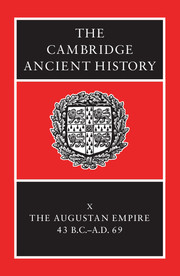13j - Cyrene
from 13 - The West
Published online by Cambridge University Press: 28 March 2008
Summary
INTRODUCTION
Modern Cyrenaica, in the Roman period variously named Cyrenae (from its chief city), the Cyrenaea, the parts around Cyrene, Libya around Cyrene, was bequeathed to Rome in default of an heir by its king Ptolemy Physcon in 155 B.C., and inherited by her on the death of his son, Ptolemy Apion, in 96 B.C. Rome freed the Greek cities (we are not told whether or not she also gave them immunity from taxation); she probably accepted ownership of the royal property at once (the estates are first unequivocally attested in her possession in 63 B.C.). The Libyans of the region were perhaps regarded as dependants of the cities.
By 75/4 B.C. it was clear that this attempt to exercise suzerainty at no cost had failed. To the literary evidence for Cyrenaican instability in the intervening years inscriptions have recently added vivid detail; there were dissensions and tyrannies within the cities, and sometimes, apparently, between them, attacks probably from Libyan raiders and certainly from pirates, famines, sieges, lootings. In this context a continuous Roman presence may well have seemed preferable to freedom, bringing a hope of peace and revived prosperity to the local population as well as to the Roman negotiators attested at Cyrene and probably present in all the cities. A senatorial decision to send a quaestor to Cyrenaica is reported of 75 or 74; the first indication of serious administrative activity is of 67, when a cluster of inscriptions records action by Cn. Cornelius Lentulus Marcellinus, a legate of Pompey in the Pirate War.
Keywords
- Type
- Chapter
- Information
- The Cambridge Ancient History , pp. 619 - 640Publisher: Cambridge University PressPrint publication year: 1996
References
- 3
- Cited by



